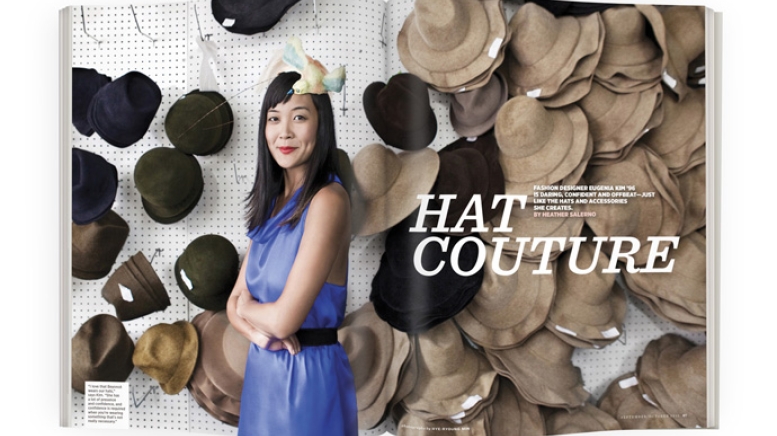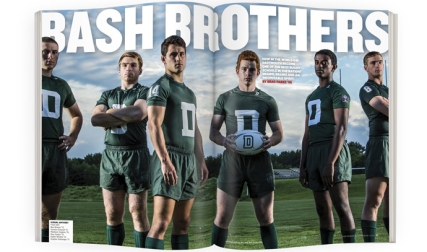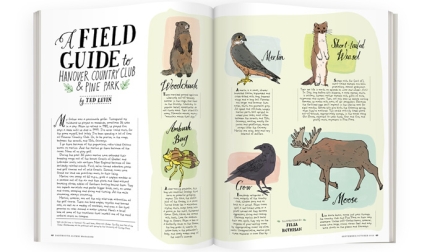Step into Eugenia Kim’s private showroom in Manhattan’s garment district and you’ll find a perfectly curated selection of the hatmaker’s latest creations. There are shelves of playful knit toppers, including the double pom-pom beanie beloved by Beyoncé and Iggy Azalea. One wall displays the same felt fedoras that Sienna Miller modeled in Vogue earlier this year. A flurry of beach-worthy styles—favorites of Taylor Swift and Katy Perry—are featured, too. One wide-brimmed sunhat is embroidered with the cheeky message, “Wish you were here.” And no Kim collection would be complete without her signature cat-ear design, such as the knit Felix cap and sculpted Caterina beret worn by Amy Poehler and Nicki Minaj.
Why are so many superstars such huge fans of Kim’s high-end headgear? “There’s this image of a Eugenia Kim girl,” the designer explains. “You have a little bit of daring. You have a little bit of confidence. You like things that are bold. And you’re a little off-center sometimes.” That description could fit Kim herself. All of those attributes—plus a rock-solid work ethic and careful attention to craftsmanship—have helped her build a niche business that has thrived for nearly two decades. Though whimsical chapeaus are still at the company’s core, including a men’s line, Mr. Kim, and a lower-priced diffusion label called Genie, Kim has expanded to shoes, scarves, gloves and other items through the years. Her brand is now sold in luxury retailers Barneys New York, Bergdorf Goodman and Saks Fifth Avenue, as well as at more than 200 specialty stores worldwide. Hollywood stylist Cher Coulter, who’s dressed fashion darlings Kate Bosworth, Nicole Richie and Rosie Huntington-Whiteley, says Kim’s designs make a dramatic statement without going too far over the top. “They are classic, but always on trend,” says Coulter.
Indeed, there’s an element of accessibility that appeals to a wide audience, not just the rich and famous. Kim gives everyday styles a hip twist: A traditional fedora might come with a hatband made of feathers or edged in tweed or gold braiding. But she swears that anyone can pull off her hats. “They just need to find the right one,” she says. Customers have plenty to choose from, far more than offerings from most designers. She’ll even create variations of the same piece: Madonna and Lady Gaga wear the $215 Marina captain’s hat embellished with a massive gold chain, but the slightly less adventurous might opt for a slimmer version with black leather trim. Each season Kim’s five-person design team produces around 500 samples, then edits down to about 250 for production. “We do a lot of development,” she says. “We want things that are good for everybody.”
On a recent warm weekday, however, Kim is unusually bare headed as she swoops into her office straight from the tennis courts near her Lower East Side apartment. Looking as if she’s come from a photo shoot instead of a competitive game, her newly colored blonde hair is shiny and sleek, with magenta lipstick and a neon-yellow manicure serving as punchy accents to her white Adidas by Stella McCartney tennis dress. She gets to work right away, checking email and talking rapid-fire about her day’s schedule. It’s resort market week, which means her sales staff is showing retail buyers next year’s vacation-wear collection. Despite having nearly 40 employees, Kim is a hands-on chief, so she’ll pop into many of those appointments. Meanwhile, she needs to attend a meeting about renting more space in the building. “We need more sewers,” she says, darting into a production room, where 10 women are stitching ribbons and other final touches to straw sunhats that just arrived from a local factory. At some point each of the 100,000 hats made annually for her line will go through this room. “A lot of what we do is artisanal on some level,” she adds. “We have couture techniques, but make it prêt-à-porter.”
The following day Kim expects to visit a downtown property. She wants to open a flagship store in New York, with an eventual rollout to other major cities. Last year she took a step toward growing her company by adding shoes, which range from studded suede ankle boots to pointed-toe flats topped with a mink bow. It wasn’t Kim’s first foray into footwear: In 2003 she introduced a well-received line that helped her win a Council of Fashion Designers accessories designer award, the fashion industry’s equivalent of an Oscar, in 2004. Kim wasn’t ready to meet production demands, however, and shuttered the venture in 2005. “Now we’re doing things the proper way,” she says of the shoe relaunch. “I’m more prepared.”
According to Jenn Wallace, an accessories buyer for boho-chic chain Anthropologie, Kim occupies a unique space in the marketplace. Wallace first met the designer in 2011, while working at Canadian department store Holt Renfrew, where she helped triple Kim’s sales by showcasing her collections through trunk shows and special appearances. Wallace attributes Kim’s success to a quirky aesthetic, as well as a close oversight of the brand. “She’s at a place where she very much could take a step back, but she still has a direct hand in everything,” says Wallace. “She’s been able to create a business in a category that’s hard to maintain longevity in. I really can’t compare her to anyone.”
It’s a business that Kim readily admits “kind of fell in my lap.” Raised in Pittsburgh, she originally planned to become a doctor like her oncologist father. But during her freshman year at Dartmouth she broke her back sledding on a cafeteria tray at the golf course. The experience made her realize that she didn’t want to go into medicine. “I was like, ‘Hospitals are depressing and sad,’ ” she recalls. “But I’m the oldest child in a Korean family that has no sons. It took me a few years to get out of the hold of my parents’ expectations.”
Graduating with a degree in psychology, Kim landed an internship at media giant Condé Nast and moved to New York. While working as an assistant at Allure magazine, she developed her fledgling interest in fashion by taking a hat-making class at the Parsons School of Design. Yet Kim was fired from Allure after a year. “I didn’t show up to work on time, even though I worked hard,” she admits. The final straw for editor-in-chief Linda Wells was when Kim wore lingerie to the office—“even though it was a Dolce & Gabbana slip dress and I’d just written about slip dresses being ‘in’ the month before,” Kim says. Devastated, she responded by giving herself a haircut—one so bad that the only remedy was to shave her head entirely. “I had to make myself hats because I looked like the Dalai Lama,” she laughs. “I’m not one of those girls like Sinéad O’Connor who looks good with no hair.”
Walking through a hip SoHo neighborhood one day, an unemployed Kim wore a red, feathered cloche she’d designed to look like hair. Several boutique owners took notice and within a week were selling her hats. Within three months she received her first order from Barneys. With a rising reputation among fashion insiders, she was soon hired to create outlandish headpieces for magazine shoots with famed photographer David LaChapelle and for films such as Zoolander. Her big break came when Jennifer Lopez wore Kim’s Honey Hat—an oversized, white floppy number—to the 2001 American Music Awards. “That was a pivotal moment,” Kim says. “I became the celebrity milliner.”
In those days, Kim says, she was an “ingénue with not much business sense.” She’s learned many lessons since, and there’s now a cautious master plan in place, one that she hopes will establish her as a full-fledged lifestyle brand. In the future she expects to branch into handbags and jewelry. “I think the time is right,” she says. “I see myself as an accessories empire that’s growing.”
Heather Salerno is a freelance writer based in the greater New York City area.




